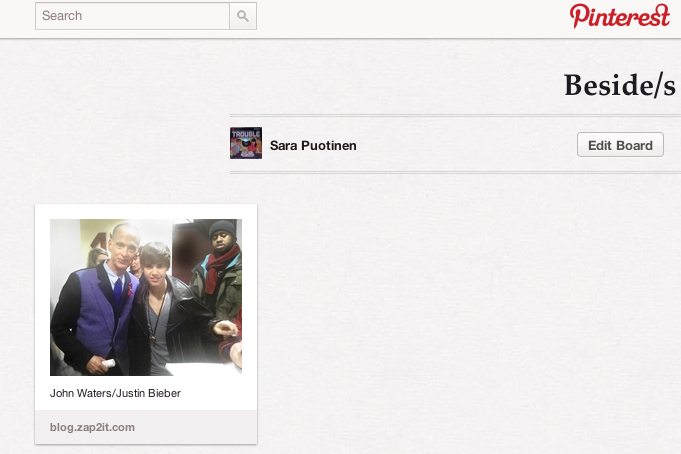Even though I’ve been wary of Pinterest over the past couple of weeks, I’m still using it. And I’ve actually found some fun/playful/useful ways in which to experiment with it. In addition to continuing to add onto my Troublemaking Role Model board, I just, a few minutes ago, created a new board: Beside/s. It’s inspired by my continued interest in beside/s as an important concept for troublemaking and troublestaying. My first pin on this board? John Waters/Justin Bieber.
While looking for an image of John Waters (I’m planning to add him to my troublemaking role model board), I came across an article headline, “Justin Bieber could win an Oscar, according to one director”. Of course, I tweeted about it:
Wow….John Waters has Bieber fever? He wants to cast #JustinBieber in movie as junkie. entertainment.gather.com/viewArticle.ac…
— Sara Puotinen (@undisciplined) February 27, 2012
I also had to post about it on my new Tumblr. Here’s what I wrote on that post:
Wow, I find this fascinating. How does it fit with my tumblr? J Waters is one of my troublemaking role models and I like to create curious/troubling/playful juxtapositions: queer camp/bieber fever, shit/bubble-gum?
I don’t think that I want to do too much theorizing about this juxtaposition, but I’m glad that John Waters/Justin Bieber inspired me to create a new Pinterest board on the concept of Beside/s. I’m not sure what I will include in it, but it could be a great space for visually representing the various juxtapositions/besides that I want to perform. This board could complement by Beside/s category on this blog. Here’s my description of that category’s purpose:
BESIDE/S: In this newly developed category (as of January, 2012), I post blog entries that enable me to experiment with being beside/s. Being beside/besides is a concept and practice that I find extremely compelling for working with and through readings, ideas, understandings, and experiences; it was the central organizing principle for my essay and blog posts on living and grieving beside Judith and for my queering ethics course last spring.
Having ideas or things beside each other is to see them as next to each other. Literally, beside is a reminder of the material spaces that we inhabit. This might mean being aware of how books that you are reading/researching reside next to each other or how multiple tabs, with the various posts you are processing, are open at the same time. Conceptually, ideas or things beside (next to) each other indicates that you are reading them together, sometimes through each other, sometimes against each other, but always in ways that recognize that the various ideas/concepts/things that you are engaging with influence and shape each other. These ideas don’t necessarily fit together (and they don’t have to), but, taken together they influence how you read, interpret, understand, and produce your own ideas. To put ideas and things beside each other is to put them into conversation with each other. The process of putting them into conversation is a form of exciting and challenging work that involves much more than sitting alone and staring painfully at a blank screen.
Beside also means besides, that is, in addition to or instead of. Besides can involve the labor of thinking about and being open to alternatives to the ideas that one is reading. It can also mean de-centering one’s own perspective or the perspective of any one idea as the Idea and considering how multiple ideas/theories/experiences outside of ourselves can provide new insights and new understandings. Embracing that which is besides enables us to be, albeit temporarily, beside (not quite outside of) ourselves.

